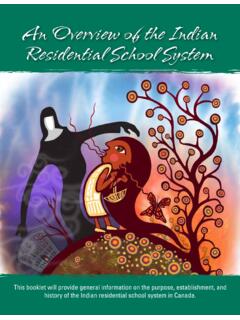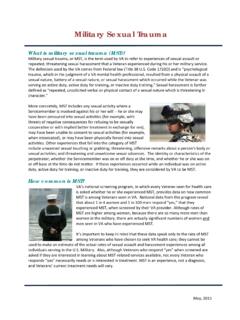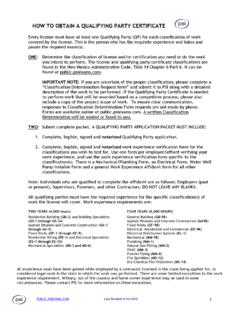Transcription of An Overview of the Indian Residential School System
1 An Overview of the Indian Residential School SystemThis booklet will provide general information on the purpose, establishment, and history of the Indian Residential School System in Overview of the Indian Residential School SystemThis booklet will provide general information on the purpose, establishment, and history of the Indian Residential School System in Union of Ontario indians gratefully acknowledges the financial contribution from the Truth and Reconciliation Commission of Canada for this : If this booklet causes any crisis or distress, call the Indian Residential Schools Crisis Line at by Donald Chr by the Union of Ontario indians based on research compiled by Karen by Creative of Ontario indians . All Rights reproduction of any of this material without written permission of the Union of Ontario indians is strictly Printing1An Overview of the Indian Residential School SystemThis booklet will provide general information on the purpose, establishment, and history of the Indian Residential School System in of the Indian Residential School System The goal of Indian Residential schools was to assimilate indians into society.
2 The Canadian government operated Indian Residential schools in partnership with the Anglican, Catholic, Methodist, and Presbyterian churches, among others. The Canadian government was financially responsible for Indian Residential schools. Indian Residential schools operated in all Canadian provinces and territories except Prince Edward Island, New Brunswick, and Newfoundland. Indian Residential schools operated in Canada between the 1870s and the 1990s. The last Indian Residential School closed in 1996. Children between the ages of 4-16 attended Indian Residential School . It is estimated that over 150,000 Indian , Inuit, and M tis children attended Indian Residential Purpose and Establishment of the Indian Residential School SystemWhat Was An Indian Residential School ?Before Residential schools existed, industrial schools existed both on and off-reserve. They were a form of manual labour School . Eventually, the industrial School model was phased out, in favour of the Residential School Indian Residential School System was mainly located off-reserve, attended by children for the duration of a 10-month academic year.
3 In some cases, children lived at the Residential School year round. The students time was divided between academic learning, religious prayer, and tasks. Why Were The Schools Created?The Indian Residential School System was based on the clearly stated goals of assimilating indians , deemed to be the most effective way to civilize the indians ..[I]f anything is to be done with the Indian , we must catch him very young. The children must be kept constantly within the circle of civilized conditions. Nicholas Flood Davin, Report on Industrial Schools for indians and Half-Breeds, Campbell Scott, who was the Deputy Minister of Indian Affairs in Canada in 1920, has been quoted on the record saying, I want to get rid of the Indian problem. I do not think as a matter of fact, that the country ought to continuously protect a class of people who are able to stand Our objective is to continue until there is not a single Indian in Canada that has not been absorbed into the body politic and there is no Indian question, and no Indian Department.
4 How Were The Schools Created?In 1884, amendments to the Indian Act, 1876 were adopted and provided for the creation of Indian Residential schools. The Indian Residential schools in Canada were predominately funded and operated by the Government of Canada and Roman Catholic, Anglican, Methodist, Presbyterian and United churches. To a lesser scale, some Indian Residential schools were funded by provincial governments or by the various religious 1920, amendments to the Indian Act make it mandatory for every Indian child between the ages of seven and six-teen years, to attend Indian Residential School . In 1933, legal guardianship of the Indian children attending Indian Residential School was assumed by the principals of those Indian Residential schools, upon the forcible surrender of legal custody by Many Children Attended The Schools?It is estimated that over 150,000 First Nations, Inuit and M tis children, between the ages of 4 and 16 years old, attended Indian Residential schools in Canada.
5 How Many Schools Were There?There are 139 Indian Residential schools identified within the Indian Residential School (IRS) Settlement Agreement. This figure represents the Residential schools that were funded and operated in whole by the federal government or in part by the federal government and a religious is to be noted that there were a number of other schools that were funded by the provincial government and/or a religious order. These schools are not included in the IRS Schools Existed in Ontario? Bishop Horden Hall (Moose Fort, Moose Factory) located in Moose Factory Island, operated by the Anglican Church. Cecilia Jeffrey (Kenora, Shoal Lake) located in Kenora, operated by the Presbyterian Church. Chapleau (St. Joseph s, St. John s) located in Chapleau, operated by the Anglican Church. Cristal Lake High School located in Cristal Lake, operated by the Mennonite Church. Fort Frances (St. Margaret s) located in Fort Frances, operated by the Catholic Church.
6 Fort William (St. Joseph s) located in Fort William, operated by the Catholic Church. McIntosh (Kenora) located in McIntosh, operated by the Catholic Church. Mohawk Institute located in Brantford, operated by the Anglican Church. Mount Elgin (Muncey, St. Thomas) located in Muncey, operated by the United Church. Pelican Lake (Pelican Falls) located in Sioux Lookout, operated by the Anglican Church. Popular Hill located in Popular Hill, operated by the Mennonite St. Anne s (Fort Albany) located in Fort Albany, operated by the Catholic Church. St. Mary s (Kenora, St. Anthony s) located in Kenora, operated by the Catholic Church. Shingwauk located in Sault Ste. Marie, operated by the Anglican Church. Spanish Boys School (Charles Garnier, St. Joseph s, Wikwemikong Industrial) located in Spanish, operated by the Catholic Church. Spanish Girls School (St. Joseph s, St. Peter s, St. Anne s, Wikwemikong Industrial) located in Spanish, op-erated by the Catholic Church.
7 Stirland Lake High School located in Stirland Lake, operated by the Mennonite Happened At The Schools?For the most part, children do not recall positive experiences while attending Indian Residential School . They were forced to abandon their language, cultural beliefs, and way of life, and mandated to adopt the European languages of English or French, foreign religious denominations, and new habits. The following is a list of some of the forced changes and unpleasant traumatic experiences lived by former students that have been documented: Forbidden to speak their Aboriginal languages Required to speak English or French Required to adopt religious denomination of the School Forced style of prayer consistent with School denomination Forced haircut, or shaved head Use of toxic chemical to clean children s hair and skin Forced to wear uniform as designed by the School Forced to shower, no access to bath tubs Lack of nutritious diet Insufficient quantities of food Served spoiled food Segregation based on gender: brothers and sisters no contact Sexual assault Forced abortions Electrical shock6 Force-feeding of own vomit when sick Exposure to freezing outside temperatures with improper clothing Withholding of medical attention Exposure to contagious illness.
8 Students with tuberculosis not segregated Forced labour in unsafe work environments Vilification of cultural traditions Use of racist language to address students Withholding presents and letters from familyHow Were Rules Enforced At The Schools?Strict rules were developed, implemented, and strictly enforced at Indian Residential schools to ensure children ac-cepted and adapted the languages, religious beliefs, and ways of are some of the documented ways that Indian Residential School staff ensured students respected the rules: Needles inserted into tongues for speaking their language Leather strap used to hit on various areas of body Beating with fists Burning and scalding hands Inflicting beatings until unconscious Starvation Shaming Public beatings of naked children Public strip search Genital search Sexual abuse Locking in closets, cages, and basementsWhen Did The Last School Close?The last Indian Residential School , located in Saskatchewan, closed in 1996.
9 7 Public Apology and the Settlement AgreementGovernment of Canada s Statement of ApologyOn June 11, 2008, Prime Minister Stephen Harper on behalf of the Government of Canada issued a public apology to Aboriginal Peoples acknowledging Canada s role in the Indian Residential Schools Speaker, I stand before you today to offer an apology to former students of Indian Residential Schools. The treatment of children in Indian Residential Schools is a sad chapter in our history . Tw o primary objectives of the Residential schools System were to remove and isolate children from the influence of their home, families, traditions and cultures, and to assimilate into the dominant culture. These objectives were based on the assumption that Aboriginal cultures and spiritual beliefs were inferior and unequal. Indeed, some saw it, as it was infamously said, to kill the Indian in the child . We now recognize that it was wrong to separate children.
10 From rich and vibrant cultures and traditions, that have created a void in many lives and communities, and we apologize for having done this. We now recognize that in separating children from their families, we undermined the ability of many to adequately parent their own children and sowed the seeds for generations to follow. The government of Canada sincerely apologizes and asks the forgiveness of the Aboriginal peoples of this country for failing them so profoundly. Indian Residential School Settlement AgreementOn March 8, 2006, the Indian Residential Schools Settlement Agreement was issued. The largest class action settle-ment in Canadian legal history , it was negotiated by several different parties representing Aboriginal organizations, religious orders, Indian Residential School survivors, and the federal Settlement Agreement includes the following six main components:1. Common Experience Payment (CEP): amount of money to be paid to all former students who attended a recognized Residential School .




